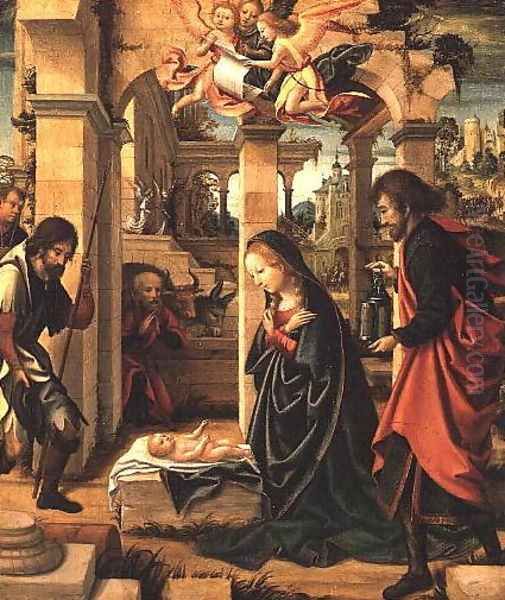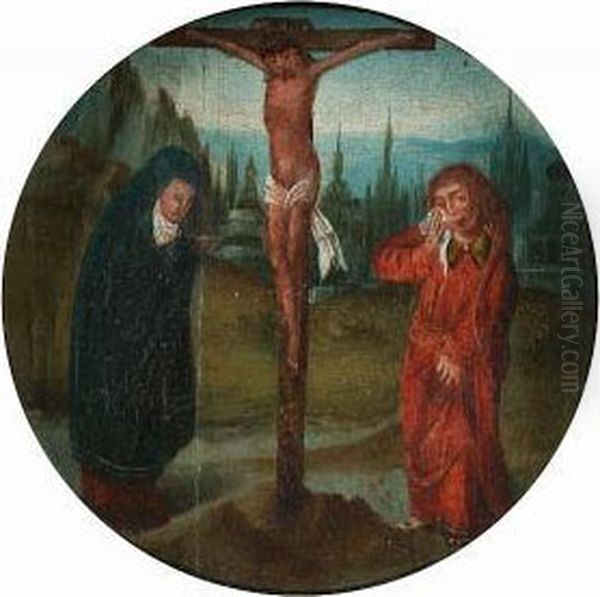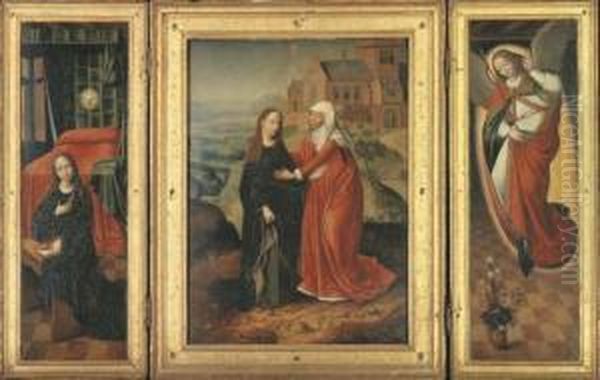Marcellus Coffermans, a name perhaps not as universally recognized as some of his contemporaries, remains a significant figure in the landscape of 16th-century Flemish art. Active primarily in Antwerp, the bustling artistic and commercial hub of Northern Europe, Coffermans carved out a niche for himself with his predominantly religious paintings. His life, spanning from approximately 1520 to 1589, placed him at a fascinating crossroads of artistic development, where the rich legacy of the Flemish Primitives met new stylistic currents and burgeoning market demands. This exploration delves into the life, work, influences, and legacy of a painter whose art, while often rooted in established conventions, reveals a complex and intriguing artistic personality.
Early Life and Artistic Formation in Antwerp
Details regarding Marcellus Coffermans's early life remain somewhat scarce, a common challenge when studying artists from this period. It is believed he may have been born in Helmond, a town not far from Antwerp, around 1520. What is more concretely documented is his establishment as a professional artist in Antwerp. In 1549, Coffermans was officially admitted as a master painter into the prestigious Guild of Saint Luke in Antwerp. This membership was a crucial step for any artist wishing to practice independently, take on apprentices, and sell their work within the city. The Guild not only regulated the quality and trade of art but also served as a vital network for artists.
Antwerp in the mid-16th century was a vibrant metropolis, a center of international trade and finance, which in turn fostered a thriving art market. Artists like Coffermans operated within this dynamic environment, catering to a diverse clientele that included local burghers, ecclesiastical patrons, and an burgeoning export market. His decision to specialize in religious subjects was common for the era, as devotional images were in high demand for both public churches and private chapels.
Artistic Influences: A Dialogue with the Past

Coffermans's artistic output demonstrates a profound engagement with the heritage of earlier Netherlandish painters, often referred to as the Flemish Primitives. His style shows a clear affinity for the meticulous detail, rich symbolism, and emotional depth characteristic of masters from the 15th century. Artists such as Rogier van der Weyden, with his poignant depictions of sorrow and piety, and Gerard David, known for his serene and beautifully crafted religious scenes, appear to have been significant touchstones for Coffermans. The influence of Hans Memling and Robert Campin (often identified as the Master of Flémalle) can also be discerned in the figural types and compositional arrangements he employed.
Interestingly, while many of his contemporaries were increasingly looking towards the Italian Renaissance for inspiration, embracing classical forms and dramatic compositions, Coffermans often seemed to consciously draw from these earlier, local traditions. This is not to say he was entirely isolated from newer trends. The influence of slightly later figures like Pieter Bruegel the Elder, particularly in the handling of landscape elements and the inclusion of everyday details, can be observed. Furthermore, his work shows an awareness of other Antwerp contemporaries and near-contemporaries like Pieter Aertsen and Pieter Coecke van Aelst, who themselves navigated the complex interplay of local tradition and international styles. The workshop of Joachim Patinir, a pioneer in landscape painting, might also have had an indirect influence, given Coffermans's own attention to background settings.
Thematic Focus and Stylistic Characteristics
The vast majority of Marcellus Coffermans's known oeuvre consists of religious paintings. He depicted popular biblical scenes such as the Nativity, the Adoration of the Magi, the Crucifixion, the Lamentation, and the Holy Family. His works are generally characterized by a clear, narrative approach, with figures often rendered with a degree of stylization that harks back to earlier models. Faces can appear somewhat elongated, with a gentle, often melancholic, expressiveness.
Coffermans typically employed oil on panel, the preferred medium of Netherlandish painters. His palette is often rich and vibrant, though sometimes with a slightly cooler tonality compared to the warmth of Italian painting. He paid considerable attention to the rendering of textures, particularly in drapery, and his compositions, while sometimes appearing archaic, are carefully constructed. While he might not have been an innovator in the same vein as some of his more revolutionary contemporaries, his skill lay in adapting and reinterpreting established iconographic traditions for his audience. His works often feature a blend of traditional elements with a burgeoning interest in more naturalistic landscapes and architectural settings, reflecting a subtle shift occurring in Northern Renaissance art.
Representative Works: A Closer Look
Several key works help to illuminate Coffermans's artistic approach and thematic preoccupations.
The Lamentation (c. 1560-1575)

This poignant theme, depicting the sorrow of Christ's followers over his dead body, was a subject Coffermans returned to. In versions of The Lamentation, such as the one dated around 1560-1575, he typically presents a group of figures—the Virgin Mary, Saint John the Evangelist, Mary Magdalene, and others—gathered around the lifeless Christ. The emotional tenor is one of quiet grief and devotion. Coffermans often draws on compositional formulas established by artists like Rogier van der Weyden, but imbues them with his own distinct figural style. The figures are often arranged in a relatively shallow space, emphasizing their emotional connection. The use of color, sometimes somber to reflect the mood, is carefully managed to guide the viewer's eye and highlight key figures.
The Adoration of the Shepherds (c. 1550)
Another popular theme, the Adoration of the Shepherds, allowed Coffermans to combine devotional piety with elements of genre. A work dated around 1550 showcases his ability to create a scene of humble reverence. The Virgin Mary and Joseph are typically depicted with the infant Christ, adored by shepherds who have come from the fields. Coffermans often includes details of rustic life and landscape backgrounds that, while not as dominant as in the works of pure landscape specialists, add a layer of realism and context to the sacred event. The figures of the shepherds are often portrayed with a simple, earnest devotion.
The Descent from the Cross (c. 1550)
This dramatic moment, as Christ's body is taken down from the cross, was a powerful subject for religious art. Coffermans's interpretations, such as one from around 1550, again often echo the compositional structures of earlier masters, notably Rogier van der Weyden's famous altarpiece. However, Coffermans often simplified the compositions and adapted the emotional intensity to suit the tastes of his patrons. He focused on the pathos of the scene, the grief of the Virgin, and the careful handling of Christ's body. His version might replace the traditional gold ground of earlier works with a more developed landscape, indicating an awareness of evolving artistic conventions.
The Holy Family with Angels (attributed, c. 1600)
A composition depicting the Holy Family—Jesus, Mary, and Joseph—often accompanied by angels, was a favored subject for private devotion. A work titled The Holy Family with Angels, sometimes dated to around 1600 (a date that notably postdates Coffermans's death, suggesting it might be a workshop piece, a copy, or a misattribution, though it is often associated with his style), would typically emphasize the tender interactions within the family unit. Angels might be shown playing musical instruments or presenting flowers, adding to the serene and idyllic atmosphere. Such paintings highlight Coffermans's ability to create intimate devotional images that resonated with the piety of his time. The somewhat problematic dating of this piece underscores the complexities art historians face when dealing with artists whose workshops were productive and whose styles were emulated.
Workshop Practices and the Spanish Market

Marcellus Coffermans appears to have run a productive workshop. The demand for religious paintings, both locally and for export, was substantial. Antwerp served as a major distribution center for art, and many Flemish paintings found their way to other parts of Europe, particularly Spain. Coffermans's works were among those exported to the Iberian Peninsula, where they were appreciated for their devotional qualities and their adherence to familiar religious iconography.
To meet this demand, it is likely that Coffermans and his workshop employed efficient production methods. This might have involved the use of standardized patterns or cartoons for figures and compositions, which could then be adapted and varied. The repetition of certain figural types and compositional schemes across his oeuvre supports this idea. His daughter, Isabella Coffermans, is also recorded as a painter, and it is highly probable that she, along with other assistants, contributed to the workshop's output. This family involvement was not uncommon in artistic enterprises of the period. The production of multiple versions of popular subjects, sometimes in varying sizes, catered to different segments of the market.
The style of Coffermans, with its clear narratives and somewhat conservative aesthetic rooted in earlier Netherlandish traditions, proved popular in Spain, where there was often a preference for the detailed realism and pious sentiment of Flemish art over the more classical or mannerist styles emanating from Italy. Artists like Adriaen Isenbrandt and Ambrosius Benson, active in Bruges, had earlier found success in the Spanish market, and Coffermans continued this tradition from Antwerp.
Coffermans's Place in Art History: Imitator or Preserver?
Art historical assessments of Marcellus Coffermans have sometimes characterized him as an "imitator" or an archaizing artist, one who looked to the past rather than forging new paths. It is true that his work often consciously references the style and compositions of 15th-century masters. He seemed less inclined to embrace the more dynamic, Italianate Mannerism that was gaining traction among some of his Antwerp contemporaries, such as Frans Floris or later, Maarten de Vos.
However, to dismiss him merely as an imitator would be an oversimplification. Coffermans was not simply copying; he was selectively adapting and reinterpreting earlier models to create works that resonated with the devotional needs and aesthetic preferences of his own time. His choice to work in a more traditional vein can be seen as a deliberate artistic stance, perhaps reflecting a conservative piety or a specific market demand for works that evoked the revered art of the past. His paintings possess a distinct character, a particular blend of sweetness, melancholy, and meticulous craftsmanship.

Furthermore, his engagement with landscape and architectural elements, even if not revolutionary, shows an awareness of contemporary developments. He was part of a broader trend in Netherlandish art that saw an increasing integration of figures within more naturalistic and detailed settings. His work can be seen as a bridge, maintaining a connection to the rich heritage of artists like Jan van Eyck and Rogier van der Weyden, while operating within the evolving artistic environment of 16th-century Antwerp, alongside figures such as Bernard van Orley (though primarily active in Brussels, his influence was felt) and the previously mentioned Pieter Aertsen and Pieter Coecke van Aelst. Even the influence of German printmakers like Martin Schongauer, whose engravings circulated widely and provided compositional sources for many painters, can be detected in the linear qualities and figural arrangements in some of Coffermans's works.
Challenges and Unanswered Questions
Like many artists of his era who were not at the absolute forefront of innovation or did not benefit from contemporary biographers like Giorgio Vasari, Marcellus Coffermans's life and career are not as fully documented as one might wish. The precise dating of many of his works remains a subject of scholarly discussion, and attributions can sometimes be uncertain, especially given the workshop practices of the time. The exact nature of his training, beyond his mastership in the Antwerp Guild, is not known.
The perception of his work has also evolved. While perhaps overshadowed in his own time and in subsequent art historical narratives by more overtly innovative figures, there has been a renewed appreciation for artists like Coffermans who represent the diverse and complex fabric of 16th-century art production. His works offer valuable insights into the continuity of artistic traditions, the functioning of the art market, and the devotional practices of the period. The "problem" of his often-retrospective style is, in itself, an interesting art historical question, prompting inquiry into the motivations behind such choices – be they personal preference, patron demand, or a conscious effort to preserve a valued artistic heritage.
Legacy and Conclusion
Marcellus Coffermans may not have revolutionized the course of art history, but he was a skilled and productive painter who successfully navigated the artistic and commercial currents of his time. His commitment to religious themes, his dialogue with the legacy of the Flemish Primitives, and his ability to produce appealing devotional images for a broad market, including significant exports to Spain, define his contribution.

His paintings, found today in museums and private collections across the world, continue to speak of a particular moment in Netherlandish art. They reflect a period of transition, where the profound artistic achievements of the 15th century were still deeply revered and actively drawn upon, even as new ideas and styles were emerging. Coffermans's art offers a window into the enduring power of traditional religious imagery and the ways in which artists could find a distinctive voice by looking to the past as much as to the present. He remains a testament to the skilled craftsmanship and devotional sincerity that characterized much of Flemish painting in the 16th century, a dedicated artist who served the spiritual and aesthetic needs of his community and beyond. His work, while perhaps quieter than that of some of his more famous contemporaries like Quentin Matsys or Jan Gossaert from an earlier Antwerp generation, forms an integral part of the rich tapestry of Northern Renaissance art.